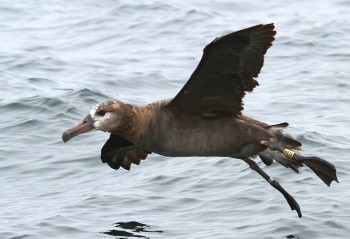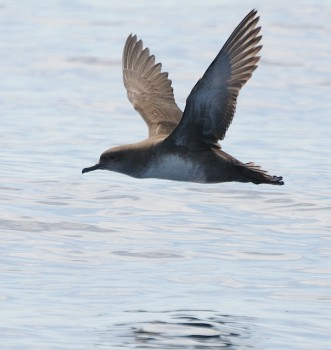ACAP held a one-day workshop on gadfly petrels of the genera Pterodroma and Pseudobulweria and other small petrels on 10 September in Wellington, New Zealand, prior to the 10th Meeting of its Advisory Committee (AC10).
The overall objective of the workshop was to advance understanding of the best approaches for international cooperation in the conservation of Pterodroma and other small burrowing petrel species and to prepare a report and recommendations for consideration at the Sixth Session of the Meeting of the Parties to the Agreement (MoP6), due to be held in South Africa in May 2018 (click here to access the workshop's agenda).

Globally Endangered Atlantic Petrel Pterodroma incerta - at risk to introduced House Mice on Gough Island, photograph by Graham Parker/Kalinka Rexer-Huber
The workshop opened with Karen Baird (New Zealand) presenting a commissioned review from BirdLife International entitled “Status, trends and conservation management needs of the Pterodroma and Pseudobulweria petrels” (click here to access the summary). The paper noted that gadfly petrels are a complex group of 39 extant species found in tropical and temperate regions. Many are single-island endemic breeders, often breeding in very remote and inaccessible areas. All are migratory, with records of at least one species in over 100 countries; and occurring as a breeder or resident in 44 countries; 26 species visit 10 or more countries. The review found that of the 39 species almost 67% are globally threatened by IUCN criteria with a further 10% Near Threatened. Fifty-eight per cent of species have a decreasing population trend, eight species have a single subpopulation and seven species have population sizes of less than 250 mature individuals. The review paper was followed by short presentations covering Pterodroma species occurring in the Americas, New Zealand and in Oceania.
Following discussion the workshop supported ACAP increasing its role in international conservation actions for gadfly petrels, and in future perhaps for shearwaters, storm petrels and the remainder of the Procellariiformes. It was recognised that an increased role was constrained by resources and should be focused on those species that would gain most from international conservation action. Overall these smaller species (both gadfly petrels and others) are affected predominately by land-based threats as opposed to the sea-based threats faced predominantly by the current ACAP-listed species.
The Pterodroma Workshop report (AC10 Doc 14 Rev 1) considered that there is a case for a limited number of additions to ACAP’s Annex 1. It also noted the need to include social science and sustainable development issues into the design and execution of invasive species eradication projects, especially on inhabited islands.
The report of the workshop was then considered by the Advisory Committee at its 10th Meeting. The recommendations endorsed by the Advisory Committee in regard to the outcomes of the Pterodroma Workshop were as follows as set out in its own report:
1. The Advisory Committee should revisit and complete a revised prioritisation process as soon as possible.
2. Based on this prioritisation and other considerations, Parties may wish to bring forward further species for consideration as additions to Annex 1 of ACAP; the Meeting of Parties might consider whether cases for addition should address the resource needs of such additions.
3. The Secretariat and Parties should improve links to existing international conservation efforts for land-based threats, particularly those working on eradication of invasive species.
4. Encourages the updating of, and possible additions to, ACAP Conservation Guidelines to ensure they adequately cover gadfly petrels and smaller Procellariiformes by the Working Groups.
5. The Population and Conservation Status Working Group and the Secretariat consider ways to improve the profile and uptake of the revised ACAP Conservation Guidelines to highlight that although they are focused on ACAP species, they also cover the smaller Procellariiformes.
6. Explore ways to increase contact with experts on smaller Procellariiformes.
The Committee agreed that the workshop report will form an annex to its own report to the 6th Session of ACAP’s Meeting of Parties, to be held in South Africa next year. It was also agreed that a contact group led by the UK and New Zealand should be established to continue discussions intersessionally regarding Pterodroma and other small burrowing petrels.
The workshop was chaired by Mark Tasker (UK) with John Cooper, ACAP Information Officer acting as rapporteur, with 30 attendees.
John Cooper. ACAP Information Officer, 03 November 2017


 English
English  Français
Français  Español
Español 



